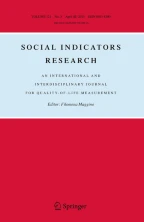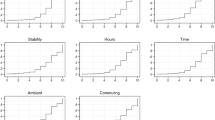How Gender-Based Disparities affect Women’s Job Satisfaction? Evidence from Euro-Area

This paper analyses how gender-based disparities in the Euro-Area affect women’s job satisfaction using the EWCS (2015), and the Global Gender Gap Index introduced by the World Economic Forum. Heckman's two-stage estimates show that women have a higher probability of job satisfaction than their male colleagues, which endorses the paradox of the female contented worker. There does not seem to be an equalization of job satisfaction as higher educational levels and lower age groups are considered. In those settings where the situation of women is more unfavourable than that of men, the probability for women to be more satisfied at work is lower. Therefore, the adaptive expectations hypothesis, by which individuals would internalize the difficulties they face and, ceteris paribus, would experience greater satisfaction than their counterparts, in this case males, is not corroborated.
This is a preview of subscription content, log in via an institution to check access.
Access this article
Subscribe and save
Springer+ Basic
€32.70 /Month
- Get 10 units per month
- Download Article/Chapter or eBook
- 1 Unit = 1 Article or 1 Chapter
- Cancel anytime
Buy Now
Price includes VAT (France)
Instant access to the full article PDF.
Rent this article via DeepDyve
Similar content being viewed by others

Gender and Job Satisfaction in Urban China: The Role of Individual, Family, and Job Characteristics
Article 05 December 2014

Are Education and Occupational Status Affecting Men’s and Women’s Satisfaction in Different Ways? A Cross-National Perspective on Gender Inequality
Chapter © 2016

Job Satisfaction and Gender in Italy: A Structural Equation Modeling Approach
Article Open access 11 August 2023
Notes
See Global Gender Gap Report, 2015,https://www.weforum.org/reports/global-gender-gap-report-2015.
The index is separated according to 4 different criteria: economic participation and opportunity, educational attainment, health and survival and political empowerment (political). The differences in the GGGI among European (19) countries is exclusively justified by the economic, opportunity and political criteria as the differences according to educational and health criteria are too small, as pointed out by Perugini and Vladisavljević (2019).
See Kim (2005) for a review of studies related to gender and job satisfaction, as well as Green et al. (2017) for a recent review of the paradox of the contented female worker.
The authors add that mobility is more reduced in the case of married men, as would be the aggregated satisfaction levels. Sousa-Poza and Sousa-Poza (2007) note, however, that job dissatisfaction does not lead to the expulsion of women from the labour market but causes a change in the job (i.e. greater job rotation) at least in the Swiss labour market, where their sample is collected.
The evidence in economic literature regarding the existence of a sample-selection bias is mixed. Clark (1997), Sloane and Williams (2000) and Long (2005) point out that there is no evidence of sample-selection bias of females into the labour market while Hauret and Williams (2017) conclude the contrary.
To contrast the existence of sample-selection bias, the entire sample has been considered.
There are other questions in the survey that reflect the degree of worker job satisfaction with respect to specific aspects of their job, but we have preferred to maintain the generality of the question and collect the overall perception of the worker.
See Herzberg’s (1967) two factors theory.
Job satisfaction can be sensitive to specific cut-off points, but our results were robust after rerunning our analysis contrasting “rarely” and “never” satisfied to more satisfied (not shown).
The cross-national weights make an adjustment to post-stratification weights to ensure that each country is represented in proportion to the size of its in-work population. Population size adjustments are based on the most recent population figures published by Eurostat or the local statistical office (6th European Working Conditions Survey Weighting report, Eurofond, 2015).
Some of these variables should not be related to job satisfaction. In our case we have included the possibility of having 2 and 3 children or more. These variables are not significant when explaining job satisfaction and have been used in other works to identify the existence of self-selection bias (Clark 2007).
The GGGI is highly correlated (0.778) to the Gender Equality Index, elaborated by the European Institute for Gender Equality, although the disaggregation of the former was more accurate for the purpose of the article, since it includes a specific section on economic participation and opportunity.
See www.weforum.org for the construction of the index.
The coefficient of the variable female and those of the rest of the variables show little change.
The decision to separate the countries into three groups was initially made through the study of the dispersion of the GGGI data. Subsequently, a contrast of means was carried out, considering the different sample sizes of the countries, to observe if the differences were significant. The analysis showed that the consideration of three groups was the most efficient.
We have considered retirement age differences in the different countries and we have performed a robustness check excluding all individuals above 55. Our results are robust by gender and by countries.
In previous studies, the interactions between higher educational levels, younger age groups and the variable female have been studied, and the positive impact of the variable female on job satisfaction continues to be observed.
It is quite possible that the results are partly biased due to the presence of other variables that reflect more accurately the effect of job insecurity.
The effect of this variable is probably captured by part-time contracts.
References
- Ahn, N. and Garcia, J.R. (2004). Job satisfaction in Europe, Working paper 2004–16, FEDEA.
- Bender, K. A., & Heywood, J. S. (2006). Job satisfaction of the highly educated: the role of gender, academic tenure and earnings. Scottish Journal of Political Economy,53(2), 253–279. ArticleGoogle Scholar
- Bender, K. A., Donohue, S., & Heywood, J. S. (2005). Job satisfaction and gender segregation. Oxford Economic Paper,57, 479–496. ArticleGoogle Scholar
- Booth, A. L., Francesconi, M., & Frank, J. (2002). Temporary jobs: Stepping stones or dead ends? The Economic Journal,112(480), 189–213. ArticleGoogle Scholar
- Borra, C., Gómez, F and Salas, M. (2007). Los determinantes de la satisfacción laboral de los economistas: evidencia a partir de una nueva muestra. Economic Working Papers E2007/02 Centro de Estudios Andaluces.
- Carleton, C. J., & Clain, S. H. (2012). Women, Men, and Job Satisfaction. Eastern Economic Journal,38(Summer), 331–355. ArticleGoogle Scholar
- Clark, A. E., & Oswald, A. J. (1996). Satisfaction and comparison income. Journal of Public Economics,61, 359–381. ArticleGoogle Scholar
- Clark, A. E. (1997). Job satisfaction and gender: why are women so happy at work? Labour Economics,4, 341–372. ArticleGoogle Scholar
- Crosby, F. J. (1982). Relative Deprivation and Working Women. Oxford University Press. Google Scholar
- Demoussis, M., & Giannakopoulos, N. (2007). Exploring Job Satisfaction in Private and Public Employment: Empirical Evidence from Greece. Labour,21(2), 333–359. ArticleGoogle Scholar
- DeSantis, V. S., & Durst, S. L. (1996). Comparing job satisfaction among public and private sector employees. The American Review of Public Administration,26(3), 327–343. ArticleGoogle Scholar
- Donohue, S. M., & Heywood, J. S. (2004). Job satisfaction and gender: an expanded specification from the NLSY. International Journal of Manpower,25(2), 211–234. ArticleGoogle Scholar
- Duncan, G. J. and Corcoran, M. (1984). Do Women 'Deserve' to Earn Less Than Men?. In Years of Poverty, Years of Plenty, edited by G. Duncan, R. Coe, M. Corcoran, M. Hill, S. Hoffman, and J. Morgan. University of Michigan, Institute for Social Research Michigan (pp. 153–172).
- England, P. and McCreary, L. (1987). Gender Inequality in Paid Employment. In Analyzing Gender, edited by Beth B. Hess and M. M. Ferree. Newbury Park, CA. Sage (pp. 286–320).
- Green C., Heywood J. Kler P. and Leeves G. (2017). Paradox Lost: Disappearing Female Job Satisfaction. Economic Working Paper Series of Lancaster University Management School 002.
- Hauret, L., & Williams, D. R. (2017). Cross-National Analysis of Gender Differences in Job Satisfaction. Industrial Relations,56(2), 203–235. Google Scholar
- Heckman, J. (1979). Sample selection bias as a specification error. Econometrica.,47(1), 153–161. ArticleGoogle Scholar
- Herzberg, F. (1966). Work and the Nature of Man. Thomas Y. Crowell. Google Scholar
- Hodson, R. (1989). Gender Differences in Job Satisfaction: Why Aren’t Women More Dissatisfied? Sociological Quarterly,30(9), 385–399. ArticleGoogle Scholar
- Kanter, R. M. (1977). Men and Women of the Corporation. Basic. Google Scholar
- Kifle, T., Kler, P., & Shankar, S. (2014). Are women really that happy at work? Australian evidence on the contented female. Applied Economics,46(7), 686–697. ArticleGoogle Scholar
- Kifle, T., Kler, P., & Shankar, S. (2019). The Underemployment-Job Satisfaction Nexus: A Study of Part-Time Employment in Australia. Social Indicators Research,143, 233–249. ArticleGoogle Scholar
- Kim, S. (2005). Gender differences in the job satisfaction of public employees: A study of Seoul metropolitan government Korea. Sex Roles,52, 667–681. ArticleGoogle Scholar
- Letourneux, V. (1998). Precarious Employment and Working Conditions in Europe. European Foundation for the Improvement of Living and Working Conditions. Google Scholar
- Long, J. E. (2005). The Effects of Tastes and Motivation on Individual Income. Industrial and Labor Relations,48(2), 338–351. ArticleGoogle Scholar
- Luo, Y. (2016). Gender and Job Satisfaction in Urban China: The Role of Individual, Family, and Job Characteristics. Social Indicators Research,125, 289–309. ArticleGoogle Scholar
- Madden, J. (1985). The Persistence of Pay Differentials: The Economics of Sex Discrimination. In Women and Work, Vol. 1, edited by L. Larwood, A. H. Stromberg, and B. A. Gutek.,Beverly Hills, Sage (pp.76–114).
- Maidani, E.A. (1991). Comparative study of Herzberg’s two-factor theory of job satisfaction among public and private sectors. Public Personnel Management, 20(4), 441–448.
- Perugini, C., & Vladisavljević, M. (2019). Gender inequality and the gender-job satisfaction paradox in Europe. Labour Economics,60, 129–147. ArticleGoogle Scholar
- Sánchez-Sánchez, N. M., & Fernández, A. C. (2019). Is women’s satisfaction higher than men’s?: self-selection, expectations of utility function. Acta Aoeconomica,69(2), 267–295. Google Scholar
- Sánchez-Sánchez, N. M., & Fernández, A. C. (2020). Public versus private job satisfaction. Is there a trade-off between wages and stability? Public Organization Review,472, 1–12. https://doi.org/10.1007/s11115-020-00472-7ArticleGoogle Scholar
- Sloane, P. J., & Ward, M. E. (2001). Cohort effects and job satisfaction of academics. Applied Economics Letters,8, 787–791. ArticleGoogle Scholar
- Sloane, P. J., & Williams, H. (2000). Job satisfaction, comparison earnings and gender. Labour,14(3), 473–501. ArticleGoogle Scholar
- Sousa-Poza, A., & Sousa-Poza, A. A. (2000). Taking another look at the gender/job satisfaction paradox. Kyklos,53, 135–152. ArticleGoogle Scholar
- Sousa-Poza, A., & Sousa-Poza, A. A. (2003). Gender differences in job satisfaction in Great Britain, 1991–2000: permanent or transitory? Applied Economics Letters,10(11), 691–694. ArticleGoogle Scholar
- Souza-Poza, A., & Sousa-Poza, A. A. (2007). The effect of job satisfaction on labour turnover by gender: An analysis for Switzerland. The Journal of Socio-Economic,36, 895–913. ArticleGoogle Scholar
- Steel, B. S., & Warner, R. L. (1990). Job satisfaction among early labor force participants: Unexpected outcomes in public and private sector comparisons. Review of Public Personnel Administration,10(3), 4–22. ArticleGoogle Scholar
Author information
Authors and Affiliations
- Faculty of Economics and Business Studies, Avda. de los Castros s/n, 39005, Santander, Spain Adolfo C. Fernández Puente & Nuria Sánchez-Sánchez
- Adolfo C. Fernández Puente



